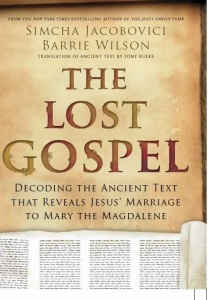Translating Joseph and Aseneth: My Role in Jacobovici and Wilson’s “Lost Gospel”
 Last Monday morning a story appeared in the press, first in England but very soon all around the world, about a “lost gospel” that contains evidence that Jesus was married to Mary Magdalene and had two children. You’ve probably heard something about it by now, and you may know I had a hand in this project—a book, The Lost Gospel: Decoding the Ancient Text that Reveals Jesus’ Marriage to Mary the Magdalene (Harper Collins, 2014) by Simcha Jacobovici and Barrie Wilson, and forthcoming documentary. The “lost gospel” of the title is a Syriac text: the Story of Joseph and Aseneth embedded in the chronicle of Pseudo-Zacharias Rhetor. I translated the text from two manuscripts at the British Library (one from the sixth-century and another from the twelfth). Since some people have been asking about the translation, and where I stand on the book’s argument, I thought I’d write something about my involvement in the project.
Last Monday morning a story appeared in the press, first in England but very soon all around the world, about a “lost gospel” that contains evidence that Jesus was married to Mary Magdalene and had two children. You’ve probably heard something about it by now, and you may know I had a hand in this project—a book, The Lost Gospel: Decoding the Ancient Text that Reveals Jesus’ Marriage to Mary the Magdalene (Harper Collins, 2014) by Simcha Jacobovici and Barrie Wilson, and forthcoming documentary. The “lost gospel” of the title is a Syriac text: the Story of Joseph and Aseneth embedded in the chronicle of Pseudo-Zacharias Rhetor. I translated the text from two manuscripts at the British Library (one from the sixth-century and another from the twelfth). Since some people have been asking about the translation, and where I stand on the book’s argument, I thought I’d write something about my involvement in the project.
About six years ago Barrie Wilson, my colleague at York, asked me if I knew of an aspiring scholar with knowledge of Syriac who could translate a text for him. He meant me. Barrie was involved in hiring me at York ten years ago and we continue even today to interact, on thesis committees, etc., though now Barrie is retired. I was looking at the time for opportunities to exercise my Syriac skills. So, for both of these reasons, I had to say yes. I think Barrie told me then (if not, soon after) that …
